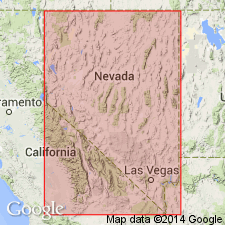
- Usage in publication:
-
- Nine Hill Tuff*
- Modifications:
-
- Named
- Reference
- Dominant lithology:
-
- Tuff
- AAPG geologic province:
-
- Great Basin province
Summary:
Named for Nine Hill. Type section: near Nine Hill, northeast 1/4 sec.29 T16N R20E, Carson City 7.5' quad, Washoe Co, NV. Reference localities: 1) near mouth of Santiago Canyon, northeast 1/4 sec.6 T15N R21E (principal reference) , 2) Eureka Canyon, southwest 1/4 sec.33 T16N R21E, New Empire 7.5' quad, 3) hills 1 mi north-northeast of Carson Airport, southwest 1/4 sec.34 T16N R20E, New Empire 7.5' quad, and 4) unnamed south-draining canyon, secs.26 and 35 T16N R20E, New Empire 7.5' quad. Ash flow tuff is pale-orange-red to reddish-purple in lower part; pale-brown to purplish-brown in upper part. Is devitrified, densely welded, and pumice-rich in lower part; vitric, weakly welded, pumice-poor in upper part, which locally includes dikes and plug-like masses of very densely welded and stretched tuff. Is 700 m thick. Unconformably overlies pre-Tertiary basement rocks and Mickey Pass Tuff; disconformably underlies Eureka Canyon Tuff (new) and younger Tertiary volcanic rocks. Is younger than Lenihan Canyon Tuff (new). Is Oligocene age based on stratigraphic relations.
Source: GNU records (USGS DDS-6; Menlo GNULEX).

- Usage in publication:
-
- Nine Hill Tuff*
- Modifications:
-
- Age modified
- AAPG geologic province:
-
- Great Basin province
Summary:
Age of the Nine Hill Tuff is modified from Oligocene to: late Oligocene and (or) early Miocene on the basis of regional stratigraphic relationships and a radiometric (K-Ar) age of approximately 25 Ma.
Source: GNU records (USGS DDS-6; Menlo GNULEX).
- Usage in publication:
-
- Nine Hill Tuff
- Modifications:
-
- Geochronologic dating
- AAPG geologic province:
-
- Great Basin province
Henry, C.D., and John, D.A., 2013, Magmatism, ash-flow tuffs, and calderas of the ignimbrite flareup in the western Nevada volcanic field, Great basin, USA: Geological Society of America, Geosphere, v. 9, no. 3, p. 951-1008., Incl. supplementary data, DOI: 10.1130/GESOO867.1
Summary:
Pg. 954, 955 (Table 1), 958 (fig. 3), 960 (Table 2), 973 (fig. 13), 975; supplemental tables, figs. Nine Hill Tuff. Is most widespread tuff; exposed from Ely area, Nevada, to western foothills of Sierra Nevada, California. Consists of two petrographic and chemical phases, a lower sparsely porphyritic high-silica rhyolite that defines its full distribution, and an upper moderately porphyritic low-silica rhyolite that is restricted to central part. Correlative with tuff of Green Springs, and unit D of Bates Mountain Tuff. Source caldera postulated to underlie Carson Sink, based on distribution of tuff (cites Deino, 1989; Best and others, 1989, New Mexico Bur. Mines Min. Res. Mem., no. 47, p. 91-133). Age is approximately 25.4 Ma; [late Oligocene (Chattian), ICS, International Chronostratigraphic Chart, v. 2013/01].
Source: Publication.
For more information, please contact Nancy Stamm, Geologic Names Committee Secretary.
Asterisk (*) indicates published by U.S. Geological Survey authors.
"No current usage" (†) implies that a name has been abandoned or has fallen into disuse. Former usage and, if known, replacement name given in parentheses ( ).
Slash (/) indicates name conflicts with nomenclatural guidelines (CSN, 1933; ACSN, 1961, 1970; NACSN, 1983, 2005, 2021). May be explained within brackets ([ ]).

